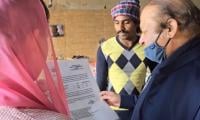Elite sports can be a short-cut to fame, wealth and glory. But playing sports at the top level is not without its risks. International sports stars fight frequent battles with fitness problems. Some of them overcome them while others succumb to one injury or the other and are forced to bow out at the prime of their careers.
Back in the late nineties, when I used to cover squash internationally, I saw first-hand how Jansher Khan’s knee injury caused a rapid decline in his world ranking and finally ended his career. From being the undisputed world number one, Jansher slipped out of the top ten and was soon a story of the past. He still had a lot of squash left in him but the record eight-time World Open champion couldn’t manage his knee injury properly. He didn’t take it seriously in the beginning and later opted for all the wrong treatments. In the end, an unsuccessful knee surgery ended his illustrious squash career. Before Jansher, his legendary predecessor Jahangir Khan also lost his battle with fitness issues and was forced to retire after ruling the sport for more than a decade.
Our top cricketers, too, face fitness issues every now and then. Sports injuries remain a major threat for international stars all over the world. Remember Neymar? The Brazilian superstar has a World Cup jinx as he broke a bone in his back during Brazil’s 2-1 quarter-final win over Colombia in 2014. Just weeks before World Cup 2018 in Russia he fractured his metatarsal in PSG’s Ligue 1 victory over Marseille in February.
Rory McIlroy was the biggest star in world golf after winning The Open Championship in 2014. The Northern Irishman was world number one at the time. Yet he was unable to defend his crown after rupturing an ankle ligament while playing football with his friends. McIlroy was forced to miss the Open and returned with a 17th place finish in the PGA Championship.
In Pakistan, sports injuries are even more frequent than in the developed world because of a lack of awareness among our sportspersons. While the rest of the sporting world has embraced latest technology, change is taking place a bit too slowly in Pakistan. However, two young surgeons are trying to accelerate it. Dr M. Kazim Rahim Najjad and Dr. Muhammad Sufyan are fully qualified surgeons, who have the expertise to treat sports injuries at their department in one of the major hospitals in Karachi - the Liaquat National Hospital (LNH).
The Department of Orthopedics at LNH is functional since 1972. Since its establishment the department has provided comprehensive musculoskeletal care for all orthopedic related conditions. It has been a centre of excellence for trauma and Arthroplasty. In 2016 the department initiated another state of the art service of Sports Injury management under the dynamic supervision of Prof. Syed Shahid Noor who is the Head of the Department. The department has two foreign trained fully qualified surgeons — Dr Kazim Rahim and Dr Sufyan. The management of LNH played a pivotal role in providing the infrastructure and state-of-the-art equipment for this service with the great vision of Dr. Salman Faridi who is the Medical Director of this hospital.
LNH’s Sports injury department offers a full range of services for sports injury related problems. There is a dedicated nutrition department which looks after the needs of nutrition of sportsmen. The Operation Theater is functional 24 hours with the state of the art equipment especially to manage minimally invasive therapeutic advanced arthroscopies for sports injuries.
The Kazim-Sufyan duo mans the sports injury department. Dr. Kazim completed his training of Sports Medicine from Germany, Iran and then France. Dr. Sufyan did his training from Germany, Singapore and United Kingdom in Sports Medicine. Both have expertise of looking after injuries from simple knee and shoulder injuries to very complex multi-ligamentous injuries of knee and shoulder. They have been managing these injuries successfully for the past two years. Management of this sort is a great service to the community as previously players and general population used to travel abroad for this sort of management. TNS interviewed the two doctors. Following are the excerpts of the interview.
TNS: How successful have you been in creating awareness about sports
injuries in Pakistan?
A: Since 2016 a lot of awareness has been created In Pakistan regarding the management of Sports injuries. Many awareness sessions have been conducted at National Bank Pakistan Sports Complex, Bahria College, City School PAF Chapter, etc. A comprehensive Sports Injury symposium was conducted at LNH in September 2018 and we are planning a series of national awareness programmes in the upcoming calendar year.
TNS: Pakistan is a sports-mad nation but still lags behind in fields like sports medicine. Do you think we can catch up with the developed world?
A: We definitely can catch up with the developed world slowly and gradually. One of the reasons due to which we are lagging is proper fitness of players and lack of guidance to sustain the stress of sports in the field. Many of our good players get an injury and are forced to end their careers in their prime. With awareness and proper centers like LNH we are on the right track towards achieving excellence in Sports medicine.
TNS: In your experience what are the most common sports-related injuries in Pakistan?
A: Most common sports injuries depend upon the type of sports a player is involved in. A lot of shoulder injuries are seen in cricket, squash and tennis players. Footballers come with a lot of knee injuries and spine is invariably involved in many sports altogether. Most of these injuries are due to improper warm up, lack of stamina and health related issues of the players.
TNS: Our high-profile sportsmen like cricketers travel abroad for any injuries. Do you think that LNH has good enough facilities to treat them?
A: LNH is in the process of transition in transforming towards a center of excellence for sports injuries management. So far we have the facility to diagnose and manage 70 to 80 percent of the injuries that might affect our high profile sportsmen.
TNS: Have you treated any national level sports persons at LNH?
A: We have treated many international and national players of different sports related fields who had joints and soft tissue related injuries which were operated upon successfully and the players are back to the their respective fields.
TNS: Do you plan to expand the sports injuries facility at LNH in the future?
A: LNH has a vision of becoming a state of the art facility in Asia and attract international Medical tourism from neighboring countries like South Asia, Middle East and Far East countries. The vision is to expand in terms of facilities and services in area of Sports medicine
TNS: What is the future of sports medicine in Pakistan?
A: The future of Sports medicine is bright in Pakistan. Many international companies which are prominent in sport injury equipment are taking interest and investing in this field. This will help us to have the latest technology available for the best treatment options for our patients. The awareness programme which we have started has helped us to educate our sportsmen about their problems and the available treatment so that they can perform to their maximum potential. We are in the process to liaison with the international sports injury forums and societies so that we can share our mutual experience. This will help us boost our clinical and surgical skills.
Khalid Hussain is Editor Sports of The News
khalidhraj@gmail.com
caption
THE DYNAMIC DUO... Dr M. Kazim Rahim Najjad and Dr. Muhammad Sufyan
caption
Neymar... is one of the most injury-prone sports stars in the world
This still shows the president of Pakistan Hockey Federation Tariq Hussain Masoori Bugti on January 29, 2024. —...
Minister for Planning and Development Ahsan Iqbal addressing the media in Lahore. — PID/FileISLAMABAD: The year 2025...
Scottie Scheffler of the United States poses with the Masters trophy after winning the 2024 Masters Tournament at...
French President Emmanuel Macron delivers a speech. —AFP/File PARIS: French President Emmanuel Macron expressed...
Former England bowler Derek Underwood . — ECB/FileLONDON: Former England bowler Derek Underwood has died at the age...
Greek tennis player Stefanos Tsitsipas. — AFP/FileBARCELONA: Rafa Nadal will return to action this week in Barcelona...







